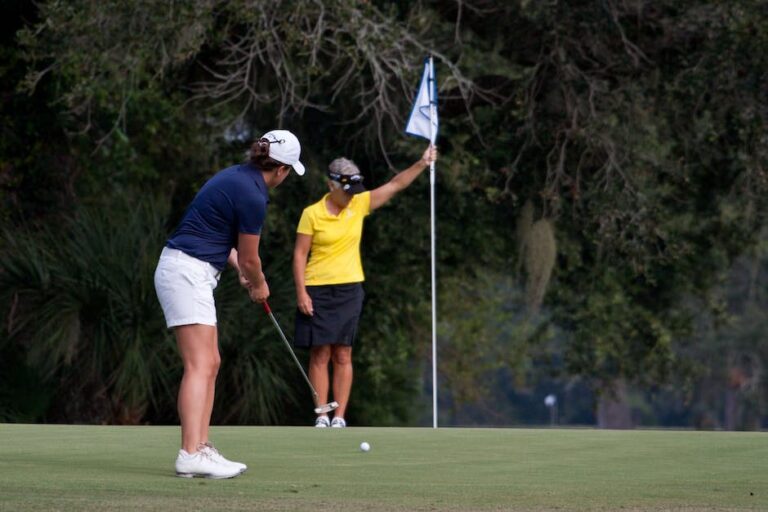Understanding the Penalties: A Guide to Disc Golf Rules Violations
One of the most common rules violations in disc golf is going out of bounds. When a player’s disc rests outside the designated course boundaries, they incur a one-stroke penalty and must play their next shot from where the disc went out of bounds.
To avoid going out of bounds, players must pay close attention to the course layout and any posted OB markers. Some courses may have painted lines or flags indicating where OB begins and ends, while others may have natural borders such as fences, roads, or water hazards.
Players must also take into account the height at which their disc traveled, as some courses may have mandatories or overhanging branches that dictate which side of the obstacle to throw on.
If a player is unsure whether their disc went out of bounds or not, they may ask their group for help in determining the disc’s lie. However, if the group cannot come to a consensus, the player must play their next shot from the last location in-bounds.
Misplaying from a Wrong Lie
Another rules violation occurs when a player throws from the wrong lie. This can happen if the player mistakenly throws from a location that is not their designated lie, or if they fail to take the proper penalty for going out of bounds or taking an unplayable lie.
In these cases, the player incurs a one-stroke penalty and must re-throw from the correct lie. If the player discovers their mistake after throwing, they must return to their correct lie and re-throw with an additional one-stroke penalty added to their score.
Players must ensure they are always throwing from their correct lie to avoid any unnecessary penalties. If a player is unsure of their correct lie, they can consult the course layout map or ask their group for assistance. As always, honesty and integrity are crucial in disc golf, and players should always err on the side of caution if there is any doubt about their lie.
Taking Unplayable Lie
In certain situations, a player may encounter an unplayable lie where their disc is obstructed or in a difficult position that prohibits a normal throwing motion. In these cases, a player can declare an unplayable lie and take the proper penalty.
Players can take an unplayable lie from any position on the course, including in-bounds and out of bounds. The penalty for taking an unplayable lie is one stroke, and the player must then re-throw from their previous lie or take a one-stroke penalty and take their next shot from a lie that is up to one disc length away from their previous spot, but no closer to the target.
Common situations where a player may declare an unplayable lie include when their disc lands in a hazard or tree, or if they cannot take a normal stance or throwing motion due to an obstacle in their way.
It’s important to declare an unplayable lie if a player is unable to make a reasonable attempt at their next throw and to always take the appropriate penalty to avoid accumulating additional penalty strokes.
Double Holed Putt
In disc golf, a double-holed putt occurs when a player’s disc lands in one of the designated baskets or targets, but then bounces or rolls into a different basket or target.
If this happens, the player must take the penalty stroke for the target they did not intend to throw into. For example, if a player throws into basket A but their disc ends up in basket B, they must mark their lie, take a one-stroke penalty for landing in basket B, and then attempt their next throw from their marked lie.
To avoid double-holed putts, players should aim carefully at the basket they intend to throw into and be aware of any unique course layouts that may present challenging basket configurations.
While a double-holed putt can be frustrating for a player and may add a stroke to their score, it’s important to remember that disc golf is ultimately a game of skill and strategy. With practice and careful attention to the rules, players can limit their penalty strokes and improve their scores.
Throwing Out of Order
Disc golf is a game that relies heavily on etiquette and player courtesy. One aspect of this is throwing in the correct order. Generally, the player who has the lowest score on the previous hole throws first on the next hole.
Players must follow the correct throwing order throughout the entire round, or they will incur a one-stroke penalty. This means that if a player throws out of turn, they must stop and re-throw their shot from their original lie.
Throwing out of order can be a common mistake, especially when players are not paying close attention to the scorecard or are distracted during play. However, players should always do their best to keep track of the order of play to avoid any unnecessary penalties.
Exceeding Time Limit
In disc golf, players are given a specific amount of time to make their throws. This time limit can vary depending on the course and level of play but is typically 30-60 seconds.
If a player exceeds the designated time limit, they will incur a one-stroke penalty. The player is allowed one warning per round, and then any subsequent violations will result in a penalty stroke.
To avoid exceeding the time limit, players can practice their throwing routine and be mindful of the pace of play. Additionally, players can use a timer or have someone in their group keep track of the time during play.
While time violations may seem insignificant, they can add up quickly and ultimately affect a player’s final score. Players should always strive to stay within the time limit to both avoid penalties and keep the game moving smoothly for all players on the course.







